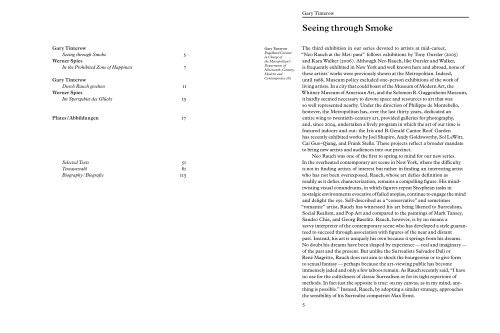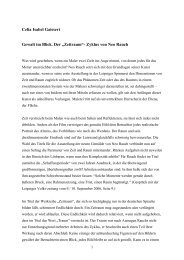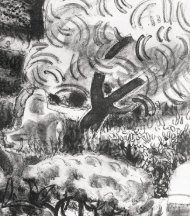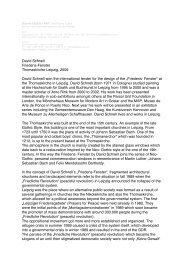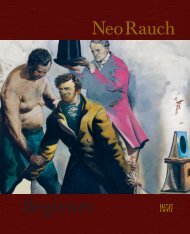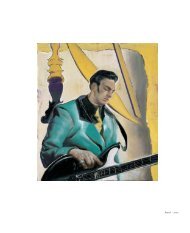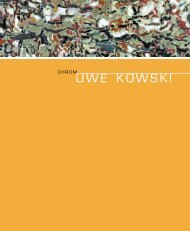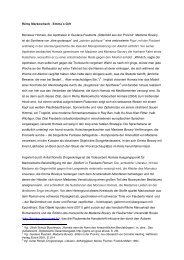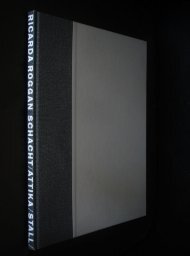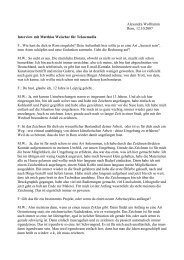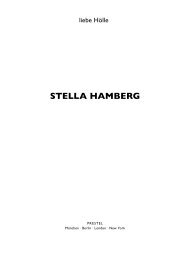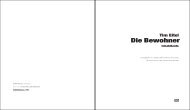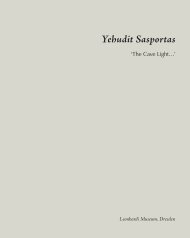Durch Rauch gesehen - Galerie EIGEN+ART
Durch Rauch gesehen - Galerie EIGEN+ART
Durch Rauch gesehen - Galerie EIGEN+ART
Sie wollen auch ein ePaper? Erhöhen Sie die Reichweite Ihrer Titel.
YUMPU macht aus Druck-PDFs automatisch weboptimierte ePaper, die Google liebt.
Gary Tinterow<br />
Seeing through Smoke 5<br />
Werner Spies<br />
In the Prohibited Zone of Happiness 7<br />
Gary Tinterow<br />
<strong>Durch</strong> <strong>Rauch</strong> <strong>gesehen</strong> 11<br />
Werner Spies<br />
Im Sperrgebiet des Glücks 13<br />
Plates / Abbildungen 17<br />
Selected Texts 51<br />
Textauswahl 81<br />
Biography / Biografie 113<br />
Gary Tinterow<br />
Engelhard Curator<br />
in Charge of<br />
the Metropolitan’s<br />
Department of<br />
Nineteenth -Century,<br />
Modern and<br />
Contemporary Art<br />
Gary Tinterow<br />
Seeing through Smoke<br />
The third exhibition in our series devoted to artists at mid-career,<br />
“Neo <strong>Rauch</strong> at the Met: para” follows exhibitions by Tony Oursler (2005)<br />
and Kara Walker (2006). Although Neo <strong>Rauch</strong>, like Oursler and Walker,<br />
is frequently exhibited in New York and well known here and abroad, none of<br />
these artists’ works were previously shown at the Metropolitan. Indeed,<br />
until 1968, Museum policy excluded one- person exhibitions of the work of<br />
living artists. In a city that could boast of the Museum of Modern Art, the<br />
Whitney Museum of American Art, and the Solomon R. Guggenheim Museum,<br />
it hardly seemed necessary to devote space and resources to art that was<br />
so well represented nearby. Under the direction of Philippe de Montebello,<br />
however, the Metropolitan has, over the last thirty years, dedicated an<br />
entire wing to twentieth-century art, provided galleries for photography,<br />
and, since 2004, undertaken a lively program in which the art of our time is<br />
featured indoors and out : the Iris and B. Gerald Cantor Roof Garden<br />
has recently exhibited works by Joel Shapiro, Andy Goldsworthy, Sol LeWitt,<br />
Cai Guo- Qiang, and Frank Stella. These projects reflect a broader mandate<br />
to bring new artists and audiences into our precinct.<br />
Neo <strong>Rauch</strong> was one of the first to spring to mind for our new series.<br />
In the overheated contemporary art scene in New York, where the difficulty<br />
is not in finding artists of interest but rather in finding an interesting artist<br />
who has not been overexposed, <strong>Rauch</strong>, whose art defies definition as<br />
readily as it defies characterization, remains a compelling figure. His mind-<br />
twisting visual conundrums, in which figures repeat Sisyphean tasks in<br />
nostalgic environments evocative of failed utopias, continue to engage the mind<br />
and delight the eye. Self-described as a “conservative” and sometimes<br />
“romantic” artist, <strong>Rauch</strong> has witnessed his art being likened to Surrealism,<br />
Social Realism, and Pop Art and compared to the paintings of Mark Tansey,<br />
Sandro Chia, and Georg Baselitz. <strong>Rauch</strong>, however, is by no means a<br />
savvy interpreter of the contemporary scene who has developed a style guaranteed<br />
to succeed through association with figures of the near and distant<br />
past. Instead, his art is uniquely his own because it springs from his dreams.<br />
No doubt his dreams have been shaped by experience — real and imaginary —<br />
of the past and the present. But unlike the Surrealists Salvador Dalí or<br />
René Magritte, <strong>Rauch</strong> does not aim to shock the bourgeoisie or to give form<br />
to sexual fantasy — perhaps because the art - viewing public has become<br />
immensely jaded and only a few taboos remain. As <strong>Rauch</strong> recently said, “I have<br />
no use for the cultishness of classic Surrealism or for its tight repertoire of<br />
methods. In fact just the opposite is true : on my canvas, as in my mind, anything<br />
is possible.” Instead, <strong>Rauch</strong>, by adopting a similar strategy, approaches<br />
the sensibility of his Surrealist compatriot Max Ernst.<br />
5


